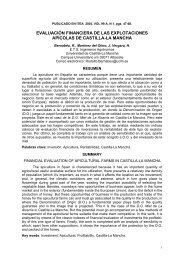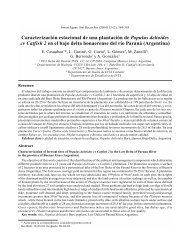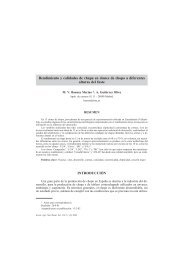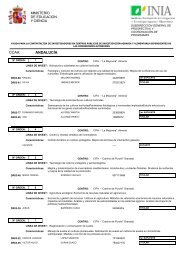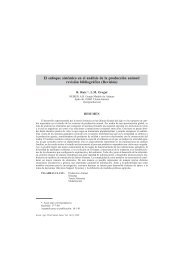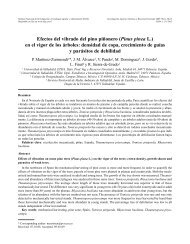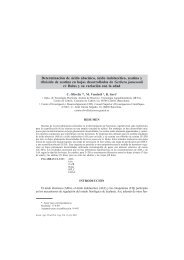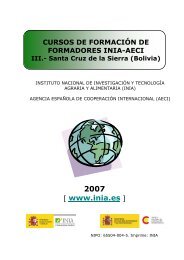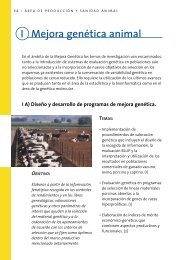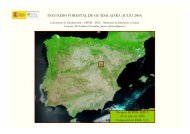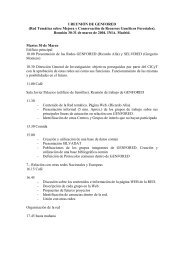Status of medicinal and aromatic plants in - Inia
Status of medicinal and aromatic plants in - Inia
Status of medicinal and aromatic plants in - Inia
Create successful ePaper yourself
Turn your PDF publications into a flip-book with our unique Google optimized e-Paper software.
PRESENTED PAPERS 75<br />
• Legislation<br />
The harvest <strong>and</strong> trade <strong>of</strong> MAPs are regulated by the Law on Protected Areas (1993, 2001), Law<br />
on Endangered Wildlife (1996), Law on Wild Vegetation (1999) <strong>and</strong> Law on Plant Genetic Resources<br />
Conservation (2001). Recently, a draft law on the ratification <strong>of</strong> the Convention on International<br />
Trade <strong>in</strong> Endangered Species <strong>of</strong> Wild Fauna <strong>and</strong> Flora was prepared. The M<strong>in</strong>istry <strong>of</strong><br />
Environment regulates the gather<strong>in</strong>g <strong>of</strong> wild MAPs <strong>and</strong> revises the list <strong>of</strong> species whose<br />
collect<strong>in</strong>g is prohibited on the basis <strong>of</strong> research carried out by specialists from the Institute <strong>of</strong><br />
Botany. The State Register (2000) <strong>of</strong> the Law on Wild Vegetation lists MAP species for which<br />
gather<strong>in</strong>g from the wild <strong>in</strong>dicated exist<strong>in</strong>g or potential conservation problems <strong>and</strong> whose<br />
collect<strong>in</strong>g is therefore limited. Some <strong>medic<strong>in</strong>al</strong> <strong>plants</strong> are <strong>in</strong>cluded <strong>in</strong> the National Red Book<br />
<strong>and</strong> are subjected to national legislation (Box 1).<br />
Box 1. List <strong>of</strong> MAP species regulated by law <strong>in</strong> Lithuania<br />
Threatened MAP species whose collect<strong>in</strong>g<br />
from the wild is regulated by law<br />
Acorus calamus<br />
Arctostaphylos uva-ursi<br />
Angelica archangelica<br />
Centhaurium erythraea<br />
Centhaurium pulchellum<br />
Cetraria isl<strong>and</strong>ica<br />
Chimophila umbellata<br />
Digitalis gr<strong>and</strong>iflora<br />
Gentiana cruciata<br />
Hierochloe australis<br />
Hierochloe odorata<br />
Helichrysum arenarium<br />
Lycopodium clavatum<br />
Origanum vulgare<br />
Potentilla erecta<br />
Polem<strong>in</strong>ium caeruleum<br />
Primula veris<br />
Plantago arenaria<br />
Sanguisorba <strong>of</strong>fic<strong>in</strong>alis<br />
Viscum album<br />
Viola tricolor<br />
MAP species <strong>in</strong>cluded <strong>in</strong> the National Red<br />
Book<br />
Arnica mntana<br />
Allium angulosum<br />
Allium v<strong>in</strong>eale<br />
Allium scorodoprasum<br />
Allium urs<strong>in</strong>um<br />
Arctium nemorosum<br />
Gentiana cruciata<br />
Hedera helix<br />
Hypericum montanum<br />
Hypericum hirsutum<br />
Mentha longifolia<br />
Polemonium coeruleum<br />
Pulmonaria angustifolia<br />
Salvia pratensis<br />
• Conservation methods<br />
Different methods are used to avoid potential danger <strong>and</strong> exist<strong>in</strong>g threats to MAP species,<br />
i.e. <strong>in</strong> situ <strong>and</strong> ex situ conservation. The biological peculiarities <strong>of</strong> species <strong>and</strong> their sources <strong>of</strong><br />
raw material determ<strong>in</strong>e the conservation method. MAP species have been divided <strong>in</strong>to three<br />
groups accord<strong>in</strong>g to the source <strong>of</strong> raw material: sufficient, limited <strong>and</strong> <strong>in</strong>sufficient (Table 1):<br />
1. For species with sufficient sources <strong>of</strong> raw material, the Law on Wild Vegetation regulates<br />
the exploitation <strong>of</strong> common species.<br />
2. Widespread species characterized by a large phenotypic diversity but with low sources <strong>of</strong><br />
raw material can be or are cultivated. Wild populations <strong>of</strong> these species are not<br />
endangered <strong>in</strong> their natural habitats; however the sampl<strong>in</strong>g <strong>of</strong> their diversity has been<br />
<strong>in</strong>itiated to ensure the conservation <strong>of</strong> their germplasm <strong>and</strong> further use <strong>in</strong> breed<strong>in</strong>g.<br />
3. Species with low sources <strong>of</strong> raw material <strong>and</strong> narrow ecological adaptation, which are<br />
difficult to <strong>in</strong>troduce <strong>in</strong>to cultivation, are <strong>in</strong> the most critical situation. This group <strong>of</strong><br />
species <strong>in</strong>cludes rare <strong>and</strong> endangered <strong>plants</strong>. The ma<strong>in</strong> factor caus<strong>in</strong>g the decrease <strong>in</strong><br />
populations <strong>of</strong> these species is the chang<strong>in</strong>g environmental conditions.




